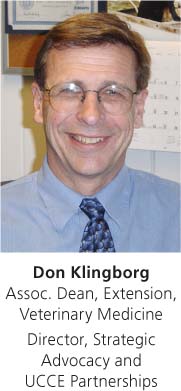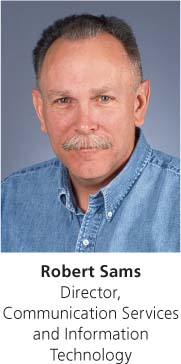All Issues
What can we do for UC today?
Publication Information
California Agriculture 64(1):2-2.
Published January 01, 2010
PDF | Citation | Permissions
Full text
AS we write this, UC students are protesting fee increases exceeding 30% next year. Each UC campus is implementing a plan to adjust to unprecedented funding cuts and rising, mandated expenses. UC Agriculture and Natural Resources (UC ANR) is restructuring business and program-support administrative offices and taking other actions to adjust to the loss of 20% of its permanent funding. To cap it all off, projections for California's budget next year show even larger deficits and threaten yet further reductions.
Don Klingborg, Assoc. Dean, Extension, Veterinary Medicine Director, Strategic, Advocacy and UCCE Partnerships
The ANR colleges at UC Davis (College of Agricultural and Envirionmental Sciences), UC Berkeley (College of Natural Resources) and UC Riverside (College of Natural and Agricultural Sciences), where many of the authors in this issue of California Agriculture are housed, all face equally difficult adjustments and reductions.
Closer to home, print production funding for California Agriculture will be reduced. To respond, the editorial staff has already begun expanding the role of California Agriculture Online ( http://californiaagriculture.ucanr.org ). The recently launched Web site, which includes the entire archive of more than 6,000 articles published since 1946 in searchable form (indexed by numerous databases), will serve as a model for other UC ANR publications and electronic information resources. Yet even as we adjust to these realities and diminished resources, the implicit value of the work of UC ANR scientists and educators grows, especially as we look to the future.
In April 2009, UC ANR released the “Strategic Vision 2025.” This document culminated months of planning, consultation and feedback. That vision, and the implementation planning that followed, builds on our tradition. To focus our efforts and identify new resources, five strategic initiatives were defined as the first to be pursued from the larger list of initiatives. These include (1) Sustainable Food Systems, (2) Endemic and Invasive Pests and Diseases, (3) Sustainable Natural Ecosystems, (4) Healthy Families and Communities and (5) Water Quality, Quantity and Security. The contents of California Agriculture illustrate the integrated and useful research that will contribute to these five initiatives.
For example, UC scientists analyze New Zealand's biological control of the invasive light brown apple moth (page 6), and consider the potential for such a system in California. Linking research and outreach, other scientists evaluate the incidence of type 2 diabetes in farmworkers, describing how healthy lifestyle and ongoing medical care can improve the prognosis in high-risk individuals (page 12). Scientists have also studied the potential health effects of airborne particulates on farmworkers (page 17). Air quality is a primary concern for many San Joaquin Valley residents, and these findings have implications for all. Other articles report on mental-health needs of low-income women (page 22), nursery industry practices that limit impacts of runoff (page 26), steps to reduce disease in pine trees (page 31), breeding Verticillium resistance in strawberries (page 37) and wine-grape trends (page 42).
At the same time, UC ANR research and extension do not stand alone. They are inseparable from and dependent on higher education and the state funding that supports it. UC President Mark Yudof and UC ANR Vice President Dan Dooley are asking advocates to contact decision-makers and to support funding for higher education and ANR research and extension. We have all benefited from previous investments in research and education. Those of us working at UC have the privilege of contributing to and earning a living from the returns on that investment.
A few weeks ago, a very upset UC student confronted a senior UC administrator with the words, “What have you, personally, done today to support state funding for UC?” We are unable to get that student's question, and the financial challenges he faces, out of our minds. We can not help but ask, “What have we done today?” If you value the research published in California Agriculture journal and the difference that UC ANR makes, we hope you will become part of this effort, called “UC for California” ( http://www.ucforcalifornia.org ).
For those of us who work at UC, we face a difficult transition — from a time when the state's citizens and our political representatives valued higher education as an investment in the future, and provided access by augmenting the budget with state dollars — to a new political reality where higher education is expected to be much more self-supporting. No longer can we assume that the voters or politicians recognize the value to the state, and to them as individuals, from investing in higher education. Today, and into the foreseeable future, an essential component of each of our tasks is to make visible the bounty of benefits that accrue from UC ANR activities. Those of us who work at UC must count on each other to remove any mystery about what we do, and demonstrate the value provided through ANR and UC in every conversation, presentation and activity. If we do not tell the story it will not be heard. Strategic advocacy as an organized component of our jobs will play a larger role in our future and we must all become involved.






